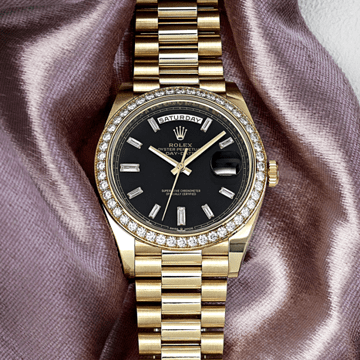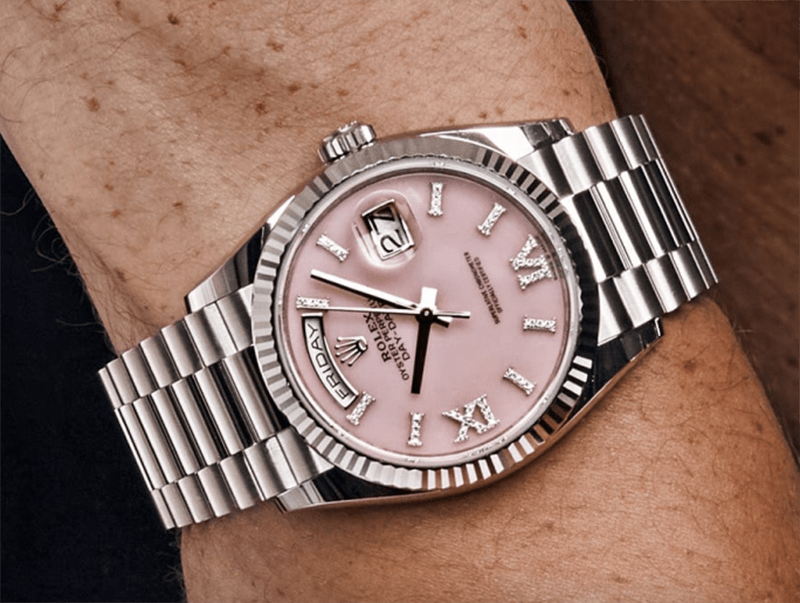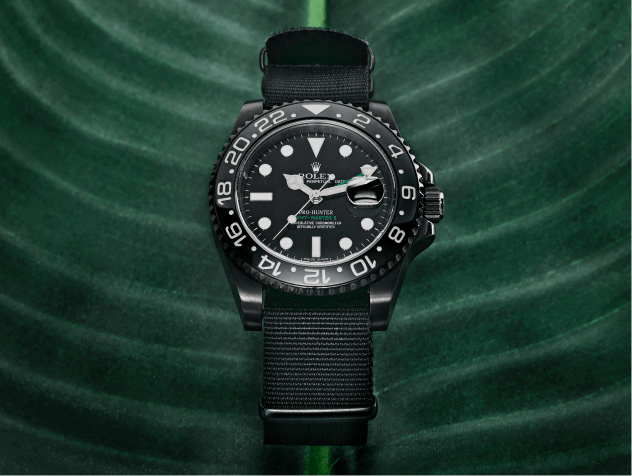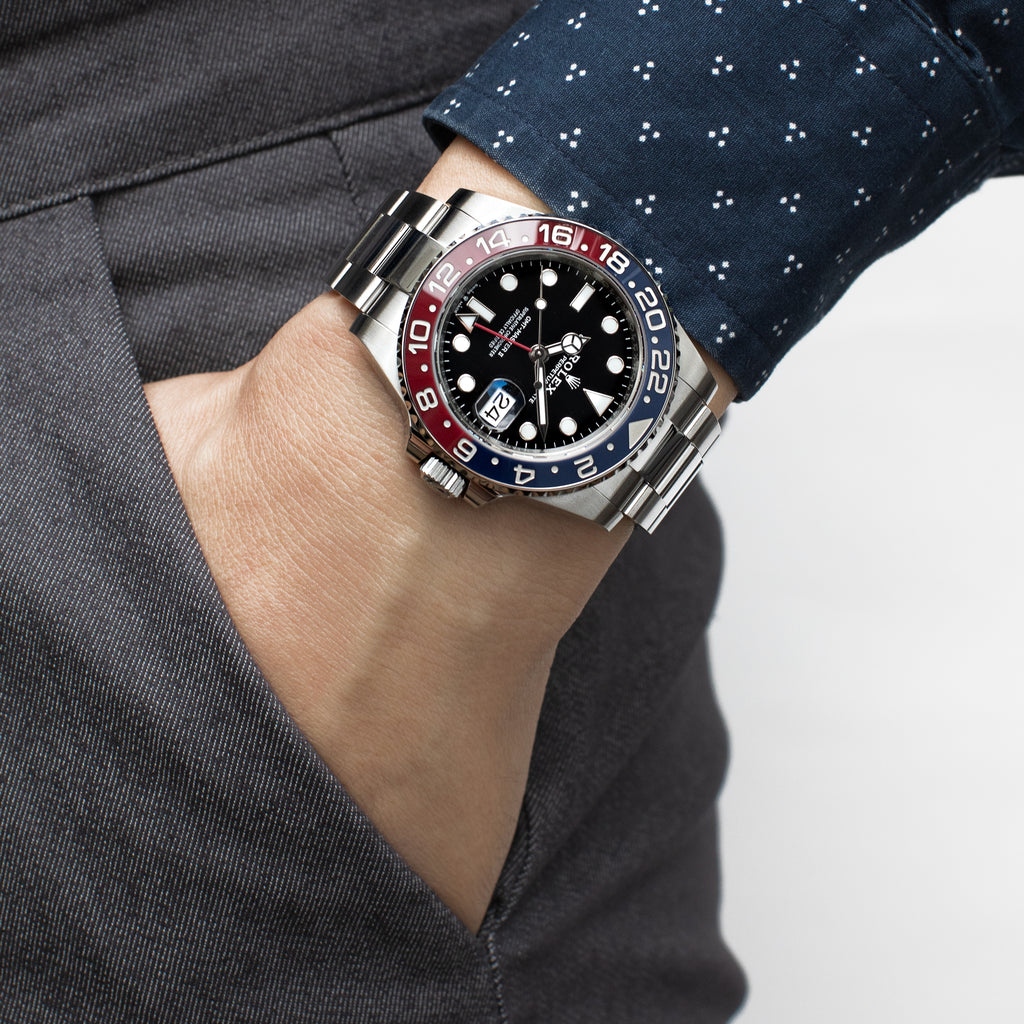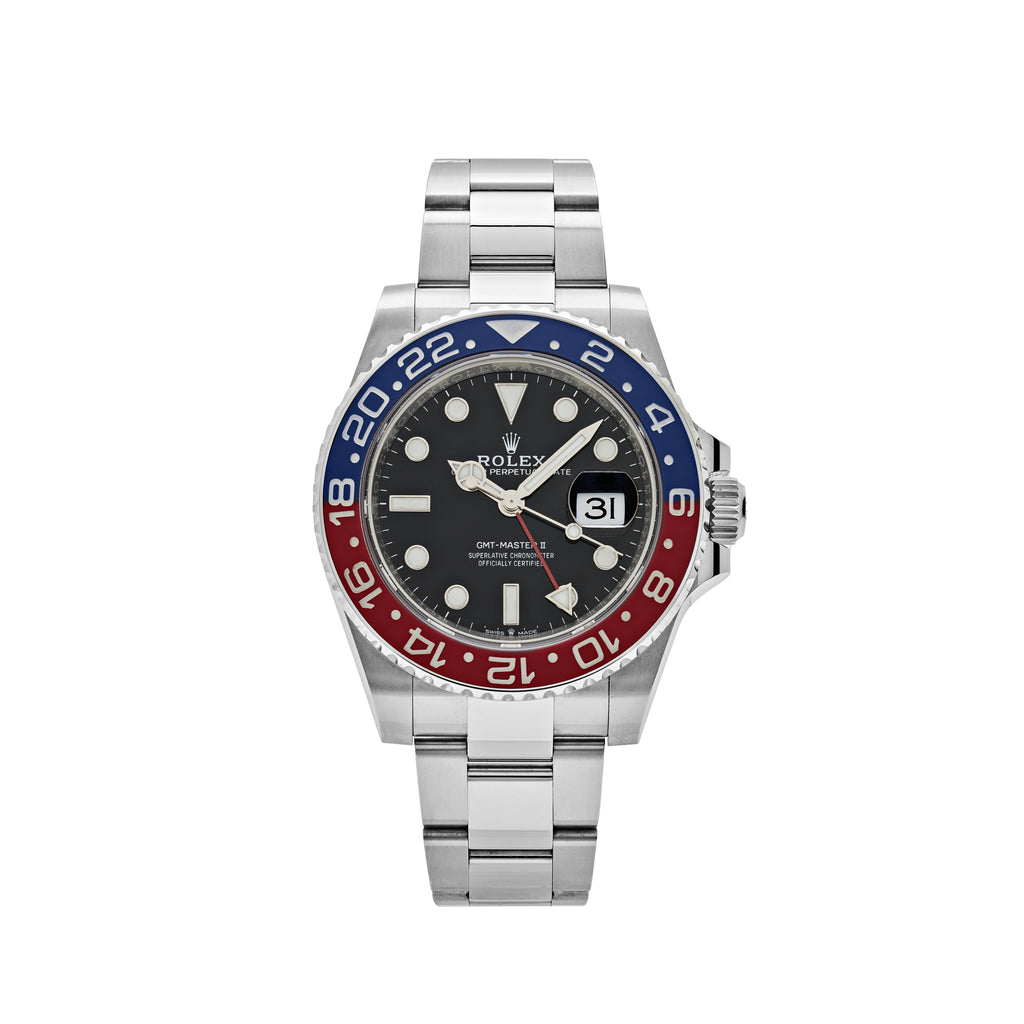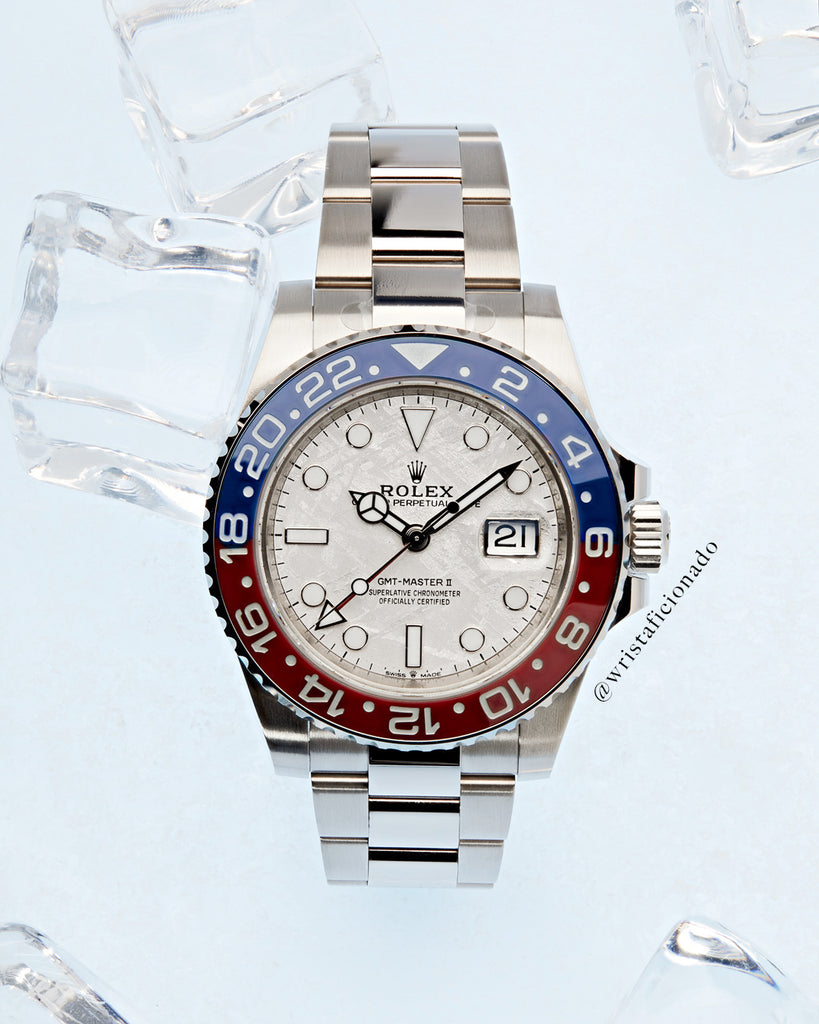Universally known by its “Pepsi” nickname, a split-color red and blue bezel has been a hallmark trait of Rolex GMT watches ever since the original GMT-Master first debuted in 1955. Over the years, Rolex’s iconic multi-timezone travel watch has continuously evolved, although the Pepsi bezel has largely endured throughout the generations, and Rolex currently offers two very different versions of the fan-favorite Pepsi GMT-Master II.
Despite their aesthetic similarities, the Rolex GMT-Master II 126719BLRO is a very different timepiece than the GMT-Master II 126710BLRO, and while both of these models are Pepsi GMT-Master II watches, one is the classic stainless steel version, while the other is crafted entirely from 18k white gold and available with a dial that is made from a slice of meteorite. So, what exactly are the differences between the Rolex GMT-Master II Pepsi 126719BLRO and the GMT-Master II Pepsi 126710BLRO, and most importantly, which one is right for you?
Rolex GMT-Master II Pepsi Watches
When Rolex first unveiled the original GMT-Master watch in 1955, a split-color red and blue bezel was chosen for the stainless steel model, and it quickly picked up the “Pepsi” nickname among collectors due to its visual similarities to the famous soda company’s logo. Throughout the years, Rolex has produced a handful of different bezel colors for the GMT-Master and GMT-Master II, although the classic red and blue Pepsi bezel remains the colorway that is most emblematic of the collection.
In the early 2000s, Rolex updated the material of its bezel inserts from aluminum to Cerachrom (the Swiss brand’s proprietary ceramic material), and the classic red and blue “Pepsi” bezel was briefly discontinued as an option from the GMT-Master II lineup. However, Rolex ultimately ended up releasing a Cerachrom version of the Pepsi bezel in 2014, and when it made its debut appearance, the ceramic Pepsi bezel was exclusively available on a solid white gold model known as the reference 116719BLRO. That said, the series received a major update in 2018, and now buyers have the choice between two different versions of the Pepsi GMT-Master II.
The two Pepsi GMT-Master II watches that are currently available in Rolex’s lineup are the ref. 126710BLRO and the ref. 126719BLRO. Both models are identical in terms of their dimensions, and both models feature red and blue ceramic bezels, 100 meters of water resistance, and they are also both powered by the Rolex Caliber 3285 automatic movement. However, while the GMT-Master II Pepsi 126710BLRO is the standard stainless steel model that is fitted with a black dial and the option of either an Oyster or Jubilee bracelet, the GMT-Master II Pepsi 126719BLRO is crafted entirely from 18k white gold, and this premium version is available with either a Midnight Blue dial or a dial that is constructed from a slice of a genuine meteorite.
Rolex GMT-Master II Pepsi 126719BLRO
Originally introduced to the catalog in 2018 as an update to the inaugural ceramic Pepsi GMT-Master II, the reference 126719BLRO is the current-production version of the 18k white gold Rolex GMT-Master II that is powered by the brand’s in-house Caliber 3285 automatic movement. All Rolex GMT-Master II 126719BLRO watches are crafted entirely from solid 18k white gold, and they are exclusively fitted with three-link Oyster bracelets, along with red and blue “Pepsi” bezel inserts that are made from Rolex’s proprietary colored ceramic material known as Cerachorm.
With that in mind, when the Rolex GMT-Master II Pepsi ref. 126719BLRO first debuted in 2018, it was only available with a Midnight Blue dial, which replaced the standard black dial that can be found inside the original white gold model from 2014 (ref. 116719BLRO). However, a Meteorite dial was added to the lineup as a premium option the following year in 2019, and Rolex continues to offer the 18k white gold GMT-Master II Pepsi 126719BLRO in both Midnight Blue and Meteorite dial configurations.
GMT-Master II 126719BLRO Key Features
- Reference Number: 126719BLRO
- Year of Introduction: 2018 (Midnight Blue dial); 2019 (Meteorite dial)
- Materials: 18k white gold
- Case Size: 40mm
- Functionality: Hours, minutes, seconds, date display, secondary timezone w/ independent local hour hand
- Bezel: Bidirectional rotating w/ red and blue split-color ceramic insert
- Dials: Midnight Blue or Meteorite w/ applied indexes in 18k white gold
- Hands: 18k white gold (Mercedes-style)
- Luminous Material: Chromalight (blue emission)
- Crystal: Sapphire (flat w/ Cyclops magnification lens)
- Movement: Rolex Caliber 3285 (automatic winding, 70-hour power reserve)
- Water Resistance: 100 meters / 330 feet
- Bracelet: Oyster bracelet w/ Easylink extension system
- Retail Price (2024): $40,600 (Midnight Blue dial); $42,900 (Meteorite dial)
Rolex GMT-Master II Pepsi 126710BLRO
Launched in 2018 as the first stainless steel model to feature the collection’s signature split-color red and blue Pepsi bezel in ceramic, the Rolex GMT-Master II ref. 126710BLRO is the current-production version of the brand’s multi-timezone travel watch. Powered by Rolex’s Caliber 3285 movement, all GMT-Master II Pepsi 126710BLRO watches are crafted from Oystersteel (904L stainless steel) and they are exclusively fitted with gloss black dials that have applied white gold hour markers.
When the Rolex GMT-Master II 126710BLRO was first introduced in 2018, it was only offered with the brand’s rounded five-link Jubilee bracelet, which helped to create a visual distinction between the stainless steel model and its more expensive 18k white gold sibling. However, among its releases unveiled at Watches & Wonders Geneva 2021, Rolex updated the stainless steel GMT-Master II models to feature the option of either Oyster or Jubilee bracelets, and you will now find GMT-Master II Pepsi 126710BLRO watches with both bracelet styles.
GMT-Master II 126710BLRO Key Features
- Reference Number: 126710BLRO
- Year of Introduction: 2018 (Jubilee bracelet); 2021 (Oyster bracelet)
- Materials: Oystersteel (stainless steel)
- Case Size: 40mm
- Functionality: Hours, minutes, seconds, date display, secondary timezone w/ independent local hour hand
- Bezel: Bidirectional rotating w/ red and blue split-color ceramic insert
- Dials: Black w/ applied indexes in 18k white gold
- Hands: 18k white gold (Mercedes-style)
- Luminous Material: Chromalight (blue emission)
- Crystal: Sapphire (flat w/ Cyclops magnification lens)
- Movement: Rolex Caliber 3285 (automatic winding, 70-hour power reserve)
- Water Resistance: 100 meters / 330 feet
- Bracelet: Oyster or Jubilee bracelet w/ Easylink extension system
- Retail Price (2024): $10,700 (Oyster bracelet); $10,900 (Jubilee bracelet)
GMT-Master II Pepsi 126719BLRO Meteorite vs. 126710BLRO
When it comes to the key differences between the Rolex GMT-Master II 126710BLRO and the GMT-Master II 126719BLRO, the most significant detail separating these two GMT-Master II models with ceramic Pepsi bezels is the material used for their cases and bracelets. While the ref. 126710BLRO is constructed from Oystersteel (Rolex’s name for its proprietary blend of 904L stainless steel), the ref. 126719BLRO is rendered entirely from 18k white gold, which means that it will be significantly heavier on the wrist, and its components will also offer a slightly warmer hue compared to those of its stainless steel sibling.
Beyond their materials, the stainless steel GMT-Master II Pepsi 126710BLRO is also available with different dial and bracelet options compared to the white gold GMT-Master II 126719BLRO. While the stainless steel ref. 126710BLRO is only offered with a standard black dial, buyers have the option of choosing their watch with either the three-link Oyster or five-link Jubilee bracelet. Alternatively, the white gold ref. 126719BLRO is available with the option of either a Midnight Blue or Meteorite dial; however, when it comes to bracelet styles, buyers only have one option, and all white gold GMT-Master II Pepsi watches are exclusively fitted with the brand’s three-link Oyster bracelet.
GMT-Master II 126719BLRO vs. 126710BLRO Price Information
When viewed at a quick glance, the stainless steel Rolex GMT-Master II Pepsi ref. 126710BLRO and the 18k white gold GMT-Master II Pepsi ref. 126719BLRO look rather similar, and they are both fitted with red and blue ceramic bezel inserts. However, given that one model is made from stainless steel and the other is crafted entirely from 18k white gold, the reference 126710BLRO and the reference 126719BLRO sit on polar opposite sides of the Rolex GMT-Master II price spectrum.
At a retail level, the stainless steel Rolex GMT-Master II Pepsi 126710BLRO is priced at $10,700 when purchased on the three-link Oyster bracelet, or $10,900 should buyers opt for it on the more intricate five-link Jubilee bracelet. Meanwhile, the solid 18k white gold Pepsi GMT-Master II 126719BLRO represents the most expensive option from the current lineup with a retail price of $40,600 when fitted with the standard Midnight Blue dial, or $42,900 should buyers opt for the Meteorite dial (as of March 2024).
On the secondary market, both versions of the Rolex GMT-Master II Pepsi trade hands for values that are greater than their original retail prices, although the premiums associated with each one differ from what exists at a retail level. For example, open-market prices for the stainless steel Pepsi GMT-Master II 126710BLRO are more than twice their retail values, while the 18k white gold Pepsi GMT-Master II 126719BLRO with a Midnight Blue dial is only slightly more expensive than its original retail price. Similarly, while the additional premium for a meteorite dial costs less than a few thousand extra dollars at retail (if you are lucky enough to find one), it ultimately translates to a five-figure premium when it comes to the value of the watch on the secondary market.
Which Rolex GMT-Master II Pepsi Watch Is Right for You?
When it comes to choosing between these two Pepsi GMT-Master II watches, both models will provide you with the same iconic red and blue split-color bezel, although each one represents a very different expression of this instantly recognizable fan-favorite style. While one model is the most affordable and utilitarian version of Rolex’s signature travel watch, the other is the most luxurious and expensive, and the important question you need to ask yourself is what role do you see the GMT-Master II Pepsi occupying in your personal collection?
If this is a watch that you plan on wearing daily, then you might want to consider the stainless steel Rolex GMT-Master II 126710BLRO. Not only can it be purchased for a significantly lower price than its white gold sibling, but its stainless steel construction means that it will be both lighter on the wrist and more resilient to the scratches and scuffs that accumulate from long-term ownership. On the other hand, if this is going to be a piece that you only wear on special occasions, then you might want to consider the meteorite dial version of the white gold GMT-Master II 126719BLRO, as it represents the absolute top-of-the-line model before you start getting into the ultra-exclusive “off-catalog” references that are encrusted in gemstones and never formally offered to the general public.
With all of that being said, although both models feature split-color red and blue ceramic bezels and offer identical specs in terms of their movement features and performance, the stainless steel Rolex GMT-Master II Pepsi 126710BLRO is a very different watch than the Meteorite dial GMT-Master 126719BLRO in white gold, and this only becomes more true when the two models are fitted with alternate styles of bracelets. While GMT-Master II watches can be found in a variety of different colorways, the iconic red and blue Pepsi bezel represents Rolex’s original vision for its multi-timezone travel watch, and there is certainly room in a collection for both of these Pepsi GMT-Master II models.

